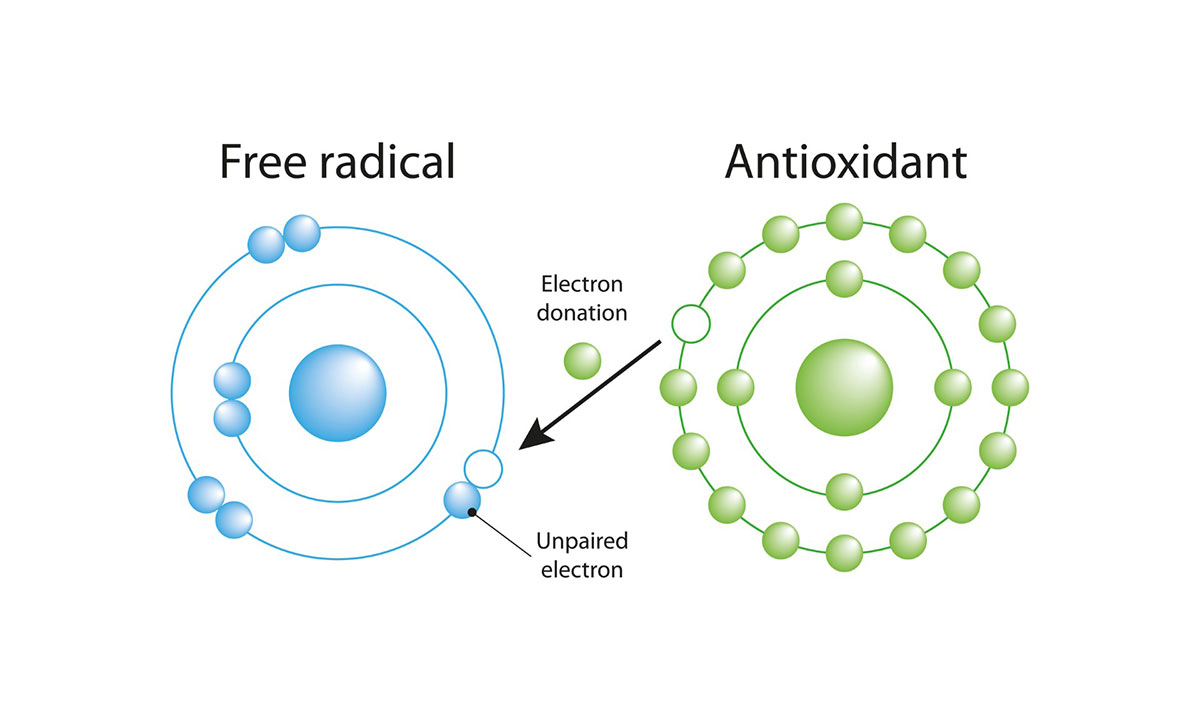Get a Free box of Gummies ($120 value) when you spend $200 or more. Now through Monday

Learn easy and accessible ways to slow or address free radical damage
Free radicals are independent atoms with one or more unpaired electrons, making them highly reactive and unstable molecules. 1, 2
These atoms are on a relentless quest to find a partner and steal an electron, causing cellular damage along the way. As soon as one free radical steals an electron, the affected molecule becomes a free radical itself, perpetuating a vicious cycle. 1, 2
This is where antioxidants come in – trusty little molecules tasked with fighting off free radicals and restoring balance. When free radicals outnumber antioxidants, oxidative stress may occur, potentially contributing to a range of adverse health conditions, from premature aging to chronic health conditions. 1, 2
In this blog we answer your questions about free radicals:
Free radicals are independent atoms with one or more unpaired electrons. These atoms are smart and know they need to replace their missing electron to remain stable. 1, 2
The best way to do this is by binding to another atom or molecule and stealing an electron. To find a partner atom or molecule, free radicals follow an unpredictable path through your cells, causing cellular damage along the way. 1, 2
As soon as one free radical steals an electron, that host molecule now becomes an unstable free radical who is on the lookout for an electron to steal. This cycle needs to be broken. 1, 2
And this is why our friends, the antioxidants, are so popular. Antioxidants are trusty little molecules tasked with fighting off free radicals and putting a stop to free radical damage. 1, 2
When there is an imbalance between free radicals and antioxidants, chaos happens. This chaos, or oxidative stress can lead to a range of side effects including cellular damage, disease, premature aging, and changes to your DNA. 1, 2, 3
Free radicals come from two primary sources: your body and environment. 2
In your body, free radicals are by-products of normal cellular processes. For example, when food is metabolized into energy, free radicals are created. And not all free radicals are a bad thing, your immune system uses free radicals to help defend against infections, and during exercise your body produces free radicals. This free radical production helps train or build your body’s natural free radical tolerance. 4, 5
Environmental and lifestyle sources of free radicals include: 2, 4, 5, 6
The primary and wide-reaching impact of excess free radicals in your body is oxidative stress.
When a free radical steals electrons from a molecule, the function and structure of the molecule is altered, causing cellular damage. This creates the cycle we mentioned above with the affected molecule becoming a free radical – ultimately leading to an imbalance between free radicals and antioxidants in your body – creating oxidative stress. 1, 2
Antioxidants are special molecules that give free radicals the extra electron they need without risk of themselves becoming a free radical. Antioxidants are often called free radical scavengers or sponges because they help stabilize free radicals. 3, 4
When you’re in long-term or chronic oxidative stress, free radicals can damage your DNA, fatty tissues, and proteins. This damage may contribute to the development of adverse health conditions, including: 3, 7, 8, 9
To slow or address free radical damage, we want you to focus on antioxidants. You want to make sure you’ve got plenty of these free radical scavengers available to work for you at all times.
The great news is that these nutrients are antioxidants: 10
The even better news is that by eating a balanced diet including a wide variety of foods and supporting your health with natural supplements, you support your body’s antioxidant needs – helping to fight off free radicals. 10
Here are some reliable and easy ways to increase your antioxidant intake: 10, 11, 12
Now that those unstable and reactive free radicals are no longer holding you back – it’s time to run wild and reap the health benefits and power of antioxidants in every part of your life.
Here’s to you for taking care of your health and doing all you can to live your best life.
To stay up-to-date with the latest from us about health, wellness, C60, and you, subscribe to our newsletter. Extra bonus – you get 10% off when you subscribe!
‡ These statements have not been evaluated by the Food and Drug Administration. These products are not intended to diagnose, treat, cure, mitigate, or prevent any disease. Individual results may vary.
[1] Lobo V, Patil A, Phatak A, Chandra N. “Free radicals, antioxidants and functional foods: Impact on human health.” Pharmacogn Rev. 2010 Jul;4(8):118-26. https://www.ncbi.nlm.nih.gov/pmc/articles/PMC3249911/
[2] Pham-Huy LA, He H, Pham-Huy C. “Free radicals, antioxidants in disease and health.” Int J Biomed Sci. 2008 Jun;4(2):89-96. https://www.ncbi.nlm.nih.gov/pmc/articles/PMC3614697/
[3] Dix, Megan. “Everything You Should Know About Oxidative Stress.” Healthline.com. (Accessed April 9, 2024) https://www.healthline.com/health/oxidative-stress
[4] Arnarson, Alti. “Antioxidants Explained in Simple Terms.” Healthline.com. (Accessed April 9, 2024) https://www.healthline.com/nutrition/antioxidants-explained
[5] Dalleck, Lance C. et al. “Free Radicals, Antioxidants and Exercise: A New Perspective.” ACE. (Accessed May 2, 2024) https://www.acefitness.org/continuing-education/prosource/november-2015/5688/free-radicals-antioxidants-and-exercise-a-new-perspective/
[6] Eldridge, Lynne. “Free Radicals: Definition, Cause, and Role in Cancer.” Verywell Health. (Accessed April 9, 2024) https://www.verywellhealth.com/information-about-free-radicals-2249103
[7] Pizzino G, Irrera N, Cucinotta M, Pallio G, Mannino F, Arcoraci V, Squadrito F, Altavilla D, Bitto A. “Oxidative Stress: Harms and Benefits for Human Health.” Oxid Med Cell Longev. 2017;2017:8416763. https://www.ncbi.nlm.nih.gov/pmc/articles/PMC5551541/
[8] Villines, Zawn. “How do free radicals affect the body?” MedicalNews Today. (Accessed April 9, 2024) https://www.medicalnewstoday.com/articles/318652
[9] Asmat U, Abad K, Ismail K. Diabetes mellitus and oxidative stress-A concise review. Saudi Pharm J. 2016 Sep;24(5):547-553. https://www.ncbi.nlm.nih.gov/pmc/articles/PMC5059829/
[10] Harvard T.H. Chan School of Public Health. “Antioxidants.” (Accessed April 9, 2024) https://www.hsph.harvard.edu/nutritionsource/antioxidants/
[11] Better Health Channel. “Antioxidants.” (Accessed April 9, 2024) https://www.betterhealth.vic.gov.au/health/healthyliving/antioxidants
[12] Meissner, Morgan. “Is Carbon 60 (C60) Good for You?” Healthline.com. (Accessed April 9, 2024) https://www.healthline.com/health/carbon-60-health-effects

Ken Swartz, MS is the co-founder, Chairman Emeritus, and former Chief Science Officer at C60 Power, a health and wellness company committed to delivering the highest quality Carbon 60 products available. Ken earned a Master of Science degree from the University of Colorado at Denver and a Bachelor of Science in Economics from Arizona State University.’